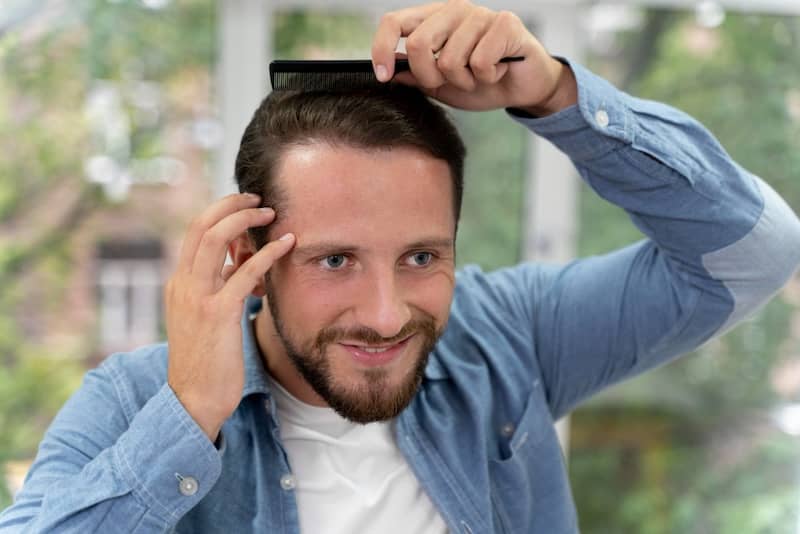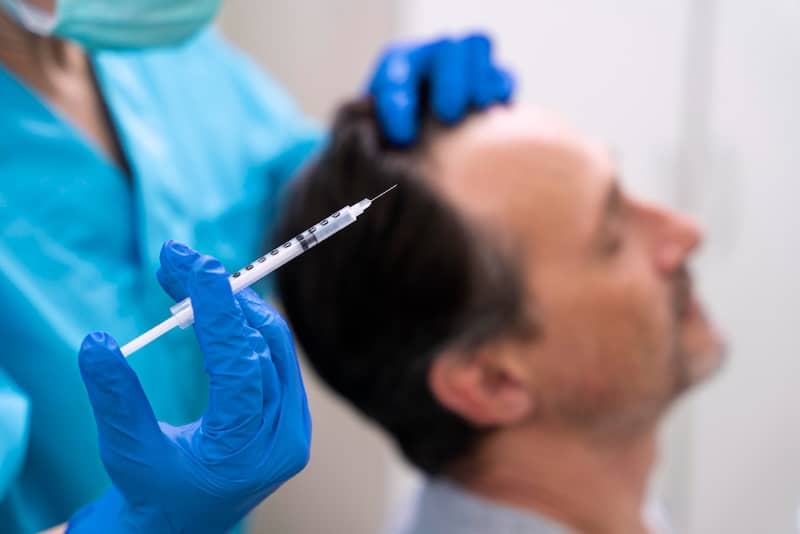
Returning to Work After a Hair Transplant
Congratulations—you did it! You stopped stressing about your hair, did the research, and took the leap. Your hair transplant is complete. You are excited to feel like yourself again. While you patiently wait for your hair to fill in, the show must go on. Are you ready to return to work?
If you want a discreet recovery, considering your professional responsibilities is important. Thanks to advancements like SmartGraft hair restoration and other follicular unit extraction (FUE) techniques, recovery times are shorter than ever. However, there are important factors to consider when planning your timeline for returning to the job.
Focus on Healing, Not Hustling
The first 48 to 72 hours after your procedure are key. Your newly implanted follicles are vulnerable to disruption, and your scalp may be sensitive, red, or slightly swollen. If your job is physically demanding or requires you to wear headgear, returning too early can put your results at risk.
For the best outcome, take a few full days to rest and recuperate. Avoid exertion and follow all post-op care instructions. This downtime gives those new follicles the best chance to anchor in and thrive.
Your Type of Work Matters
Not every job has the same physical demands or public visibility. If you work in an office setting where you sit most of the day or have the option of working remotely, you may be able to resume light tasks after just a few days. However, if your role involves heavy lifting, sweating, wearing hats, or outdoor exposure to the sun, you should consider taking more time off or modifying your duties. This is especially true if you are experiencing scalp sensitivity.
Appearance During Recovery
Even with the most refined techniques, you’ll have visible signs of the procedure for several days post-transplant. These might include redness, scabbing, or a shaved area, depending on the type of transplant and your hairstyle before surgery.
If you’re concerned about coworkers or clients noticing, consider scheduling your procedure before a long weekend or vacation. This timing will give you more time for visible signs to fade before facing others. Wearing a loose-fitting hat or hood might be tempting, but you should avoid any headwear unless it’s been specifically cleared by your hair restoration clinic. Pressure or friction on the grafts can interfere with healing.
When Is It Safe to Return?
For most patients, it’s safe to return to work within three to five days after receiving hair transplant services, especially if your job doesn’t involve physical labor or harsh environments such as extreme heat. By day five, the grafts are typically secure enough that normal movement and light activity won’t disturb them. However, full recovery continues for several weeks, so remain cautious even after you return to work.
If your job is physically demanding, you may need seven to 10 days off to allow for healing. Some people schedule their transplant toward the end of the week and return to work the following Monday. Others use paid time off to stretch out their recovery window. The best choice depends on your role, your lifestyle, and the pace of your healing process.
Returning Comfortably and Confidently
Going back to work after a hair transplant doesn’t have to feel awkward or stressful. With the right preparation, you can ease back into your routine while still protecting your investment in new hair growth.
Here are some tips to make the transition smoother:
Communicate in Advance
If your job requires special headgear or you expect questions from coworkers, plan ahead. You don’t have to go into detail, just share what you’re comfortable with.
Take Breaks and Avoid Sweating
During the first week back, avoid getting overheated or sweating excessively. If possible, take breaks in cool, shaded areas.
Stay on Top of Your Aftercare
Even when back at work, make time for your scalp care routine. Cleanse gently, stay hydrated, and avoid scratching or picking at any scabs.
Embrace the Transformation
If you feel self-conscious about your appearance while healing, remember that the results will speak for themselves in a few months. Confidence grows as your hair does.
Recovery Timeline
Along with tips for easing the transition, it’s helpful to consider the overall recovery timeline as you plan your return to work. Here is what to expect each day, so you can adequately manage your commitments and expectations.
-
- Days 1 to 3: Rest at home, avoid physical activity, keep your scalp clean and protected.
- Days 4 to 5: Begin to resume light work duties if you’re feeling up to it and your job is non-physical.
- Days 6 to 10: Visible scabbing starts to fade; many people return to the office or resume light physical activity.
- After Day 10: Most signs of the procedure have diminished. You can resume normal activities with fewer restrictions.
Working Out and Physical Labor
While returning to work is likely your priority, you should also think about when it’s safe to resume workouts or heavy physical activity. If you’re lifting weights, doing cardio, or working outdoors, it’s best to wait at least 10 to 14 days to avoid disturbing the grafts or irritating your scalp.
10 to 14 days is also the guideline for returning to jobs in construction, delivery driving, or anything that involves helmets or sweating. Your hair transplant specialist will give you tailored instructions based on your profession, but always err on the side of caution when physical effort is involved.
When to Contact Your Clinic
If you return to work and notice anything unusual, such as increased swelling, discomfort, or bleeding, contact your clinic right away. It’s rare, but some patients may experience mild inflammation that needs professional attention. Early intervention helps ensure your grafts stay healthy and your healing continues on track.
You should also keep your scheduled follow-up appointments, whether in person or virtual. These check-ins give your provider a chance to assess your progress and address any questions you may have about working, styling, or managing your hair during the regrowth phase.
The Right Team to Guide You
Hair restoration is not one size fits all; considering each person’s unique circumstances is key to success. Whether you’re a desk worker, an athlete, or someone with a more physically active job, you need a recovery plan that fits your lifestyle. That way, when you step back into work, you’re doing it with confidence and peace of mind.
When you choose a trusted hair restoration clinic like AdvancedYOU, you’re not just getting expert surgical care; you’re also gaining a support system for every stage of recovery. From initial research and transplant to personalized aftercare and clear return-to-work guidelines, your comfort and results are the top priority.
Infographic
Returning to work after a hair transplant involves balancing your recovery and professional responsibilities. The timeline for this largely depends on the nature of your job and how your body heals. Discover nine helpful work tips for after a hair transplant in this infographic.
Are you ready for your SmartGraft hair restoration journey with AdvancedYOU?
Hair Restoration in Dallas by AdvancedYOU is the Highest quality Hair Transplants for men and women in Dallas, TX. Restore your hair today!
Call or text us today at 214-949-4195for your confidential consultation. Let the most reputable provider in the country, SmartGraft master trainer Tony Bernal, restore your hair and self-confidence.











